Hard Boiled Sweets is a British gangster movie set in the Essex town of Southend a mixture of Elmore Leonard and film Noir…but set in England. I watched the finished film yesterday and it was a brilliant, entertaining movie. The added cool thing is this was shot entirely on a Canon 5DmkII and it looks fantastic.
I have speaking to director David LG Hughes for quite some time about the project and I was asked to be DP for it. A very flattering offer but due to my overseas work commitments for the scheduled shoot and my limited experience in drama work at that point, my main field being documentary I was not able to do it…but he got the excellent Sara Deane to lens it for him. It really is a beautiful looking film.
David, Sara and colourist Gavin have kindly written some words for me about the film, their influences, the shoot, dealing with the DSLR limitations and of course post.
The film opens at the Empire Leicester Square on March 9th and will play for the rest of the month. It debuts on blu ray the following month. If you want to see a terrific british film on the big screen then get down there and if you have never seen a 5DmkII movie on the big screen now is your chance, as Red Tails doesn’t look like it is getting a release outside of the US!
PHILIP BLOOM (PB) IS IN BOLD BLACK
WRITER/DIRECTOR DAVID LG HUGHES (DLGH) IS IN NORMAL BLACK
DoP SARA DEANE (SD) IS IN RED
POST PRODUCTION SUPERVISOR GAVIN BURRIDGE (GB) IS IN BLUE
PB: When you made the short film was it always the plan to make a feature based upon it?
DLGH: Absolutely. Just not this feature. After I made the short, A GIRL AND A GUN it got picked up by iTunes and did really well. It made the top ten of all the download charts – US, UK, Germany, wherever it was released. The sales agent for A GIRL AND A GUN told me it was one of the top 5 selling shorts worldwide on iTunes. So with that in the bank I thought I’d write a big budget blockbuster that would cost $50 million dollars to make. And guess what? No one was interested in reading a $50 million dollar project by a guy who’d made one short, let alone funding it! So I stuck that script in a drawer and came up with something way cheaper. And that was HARD BOILED SWEETS.
PB: How long and how hard was it to get to the point where you could make the feature?
DLGH: Starting wasn’t so hard. I had 2 great actors in A GIRL AND A GUN – Ian Hart and Paul Freeman. Plus the producer, Margaret Matheson, who has a legendary CV. She has been my unofficial mentor since the short film. Everything that’s happened is down to the kindness that those 3 people have shown me. They have brilliant reputations and names within the industry. And they stood by my side and said we’re making HARD BOILED SWEETS with Dave. A lot of people have worked really hard and given so much to the film. But Ian, Paul and Margaret came onboard first. And without them I’d still dreaming about making a movie.
PB: The cast were great. How did you attract such a talented group, especially established names like the legendary Paul Freeman (Belloq in Raiders of the lost ark) and the genius Ian Hart?
DLGH: Well, Ian and Paul were both in the short, A GIRL AND A GUN. And we got Ian first. Because my buddy and composer Tom E Morrison’s kids went to school with Ian’s at the time. And Tom is this incredible guy. He just makes things happen. So he said let me take your script to the school gate and give it to Ian. Which he did. And I thought we’d never hear from him. Because I’m naturally pessimistic! But 2 days later my phone goes and it’s Ian telling me he’s in. And from there Margaret asked a casting agent for a favor and he got the script to Paul, who thought it was a blast and came onboard.
And after the short – where we all got on great – we stayed in touch. Stayed pals. So I could send them scripts for feedback which was so valuable. Getting brilliant actors to give you feed back, amazing. I learnt so much. Improved so much.
Then I came up with HARD BOILED SWEETS and showed them first and they said yes. And then we got a wonderful casting director called Jane Anderson onboard and she brought together the rest of the cast. And of course it was a film with Ian Hart and Paul Freeman, executive produced by Margaret Matheson. So it meant something rather than by a guy who’s made one short and is clueless.
In fact, the whole structure of the movie came from my desire to work with great actors. We had no money. So I knew I couldn’t expect to get two or three really good actors to give me a month. So I wrote this large ensemble piece hoping I could get lots of great actors to give me a week, or a few days. And it worked out.
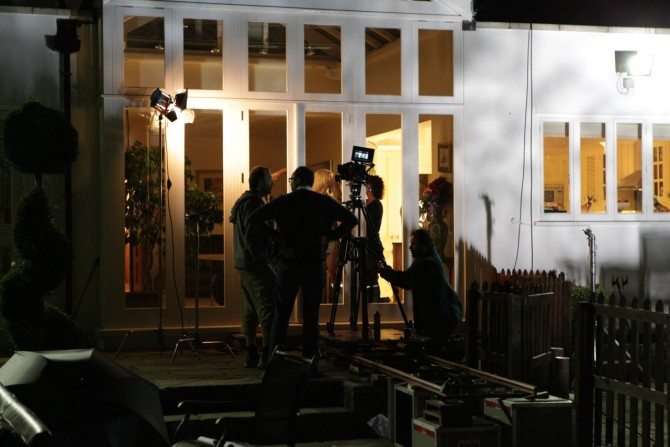
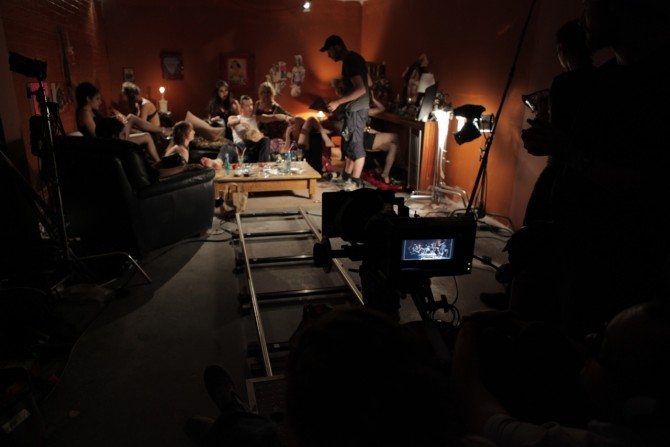
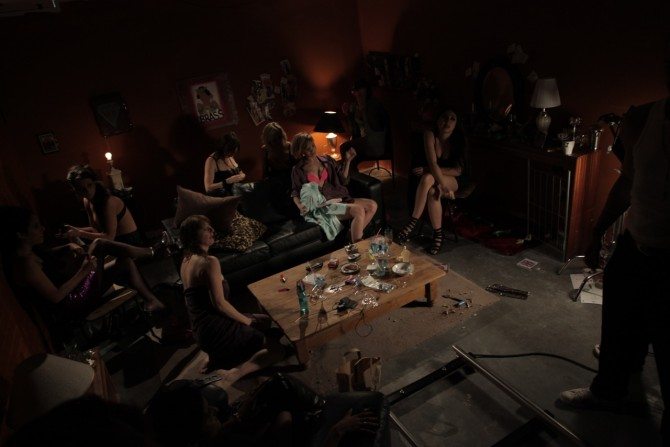
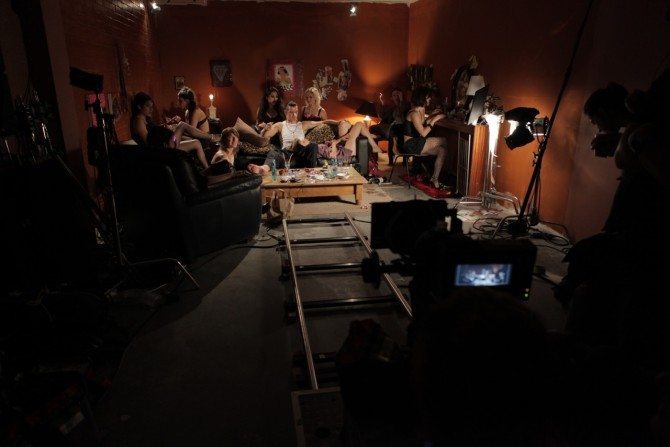
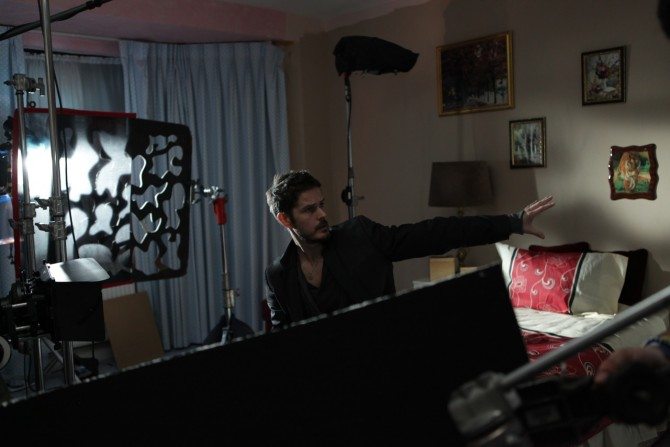
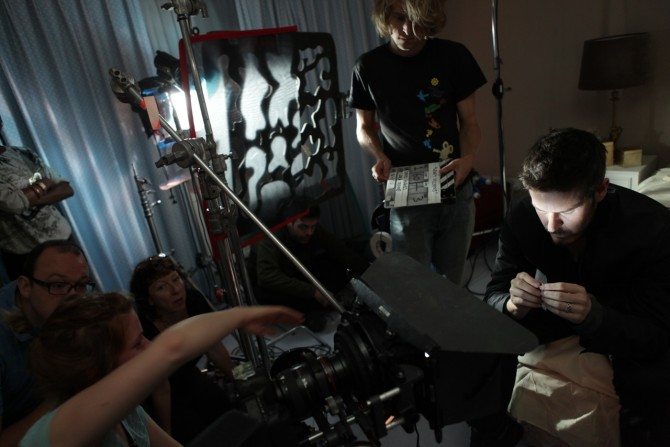
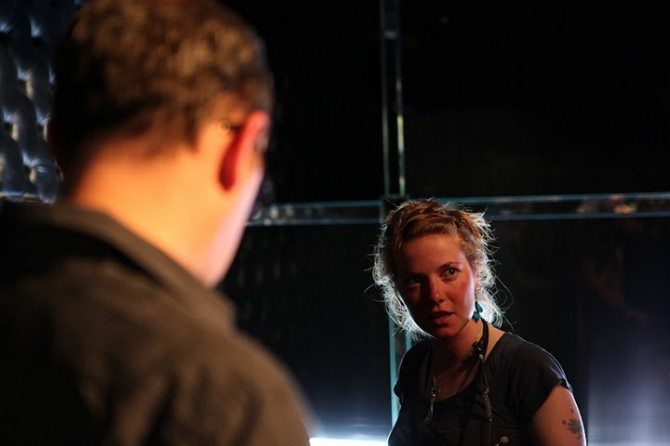
PB: Shooting…why did you choose the 5DmkII?
DLGH: The idea to shoot on the 5D was originally mine – I take full responsibility, because it wasn’t always easy for the DoP Sara Deane to work with. You know, I saw the Vincent Laforet’s ‘Revererie’ and was just blown away. And then I started to internet research the camera like mad. And I found your site, and I bought your F Stop Academy tutorial. Pretty much everything I learnt came from your site and tutorials, And I actually went out and bought the camera and 3 lenses, and that’s what we shot on.
Originally I thought I could teach myself to shoot it. So I’d direct, stick one of those zoom microphones on there and record sound too. Easy, right? And then I came to my senses and found Sara Deane.
And this is really where Sara needs to come in…
SD: I came on board the project 2 weeks before shooting so by then the decision had already been made to shoot on a 5D. I think Dave had seen a short film shot in the US using all available light and he was really impressed with the camera. I guess within our budget limitations shooting on the 5d made everything possible – in terms of that I think it really is a revolutionary camera – a few years ago buying a camera of the equivalent value you’d get something like a Z1 and I just don’t think you could /should shoot a feature on that, unless that’s the style you’re after! I had just shot another feature in Northumberland “Verity’s Summer” on the 5D so I was already pretty aware of its limitations – small latitude which is more like shooting on reversal really – you have to be bang on with the exposure especially in high contrast scenes because you just can’t bring it back and the image does fall apart quite quickly in the grade if your not careful, moire – even on things like hair sometimes! Rolling shutter – meaning fast pans/tracks and energetic hand held are out. That was part of the reason for using a lot of slow developing tracking shots but also we wanted to pull the viewer into the story and that kind of camera movement does suck you in. Also we wanted the world the characters inhabited to be quite heightened and stylised so we were after something slick – no hand held kitchen sink style.
There were also obviously some great things about the camera – lovely shallow depth of field, it’s small, meaning you can use lightweight sticks and accessories and it’s great for rigging in small places – we put it in a fridge, and a drawer whilst we were shooting and did a lot of overhead shots which were very fast to do as its such a lightweight camera it was very simple for Kevin Foy our fantastic grip to do a goal post rig. On the one hand its great for car rigs as it is so small you can use a 3 way limpet mount and get it in loads of places easily and quickly, but the massive downside is the vibration problems and wobble you get that just can’t really be fixed in post.
We shot using Canon L series zooms which I think are great for the price – they are still super sharp at 2.8 and they match each other well. Obviously there are lots of other older lenses out there that flare nicely and have a nice soft quality but it can be tricky to find a nice matching set and the L series were what we had! The main problem with these are the lack of accurate markings and I like quite shallow depth of field so I was extremely lucky to have an amazing focus puller Adam Conlon that could actually do it and manage not to throw me or the camera out the window when his marks went out of line on those lenses!
The other big annoyance shooting with the 5D was the monitoring situation – when we turned over the aspect ratio goes out of whack as the camera drops down to 480p and you loose all image for quite a few seconds, we were shooting 2.35:1 so trying to mark up the monitor was a massive pain so in the end I think we might have stoppped using it. Also it meant Dave had to lean over my shoulder to be able to see anything – pretty annoying for him!
There are a lot of different locations in the script which helps to create a nice pace to the story and was great to help create a really rich and varied atmosphere. I mostly used hard and directional lighting often creating pools of light for people to step into and I was perfectly happy for the light to be unmotivated as we wanted to create this heightened and stylised world; it was more about it being stylish and bringing out the characters.
We had quite a few different gaffers over the period of the shoot and we were lucky to have a really hard working team. Panalux and Panavision were amazingly helpful supplying the lighting gear and camera accessories. We didn’t have a genny so were mostly working with lamps up to 2.5K HMI’s but we had all the lights we needed for the job which really made the stylised look we were after possible. Mostly we had 2-3 sparks, a gaffer, focus puller, grip and a dit.
PB: It has a very slick style which I loved. What were your influences and how did you decide upon this?
DLGH: Well, going in my thought was this is not going to look like any other low budget English film. So hand held camera was banned. Naturalistic lighting was banned. I was hoping we could make the film look like the abandoned love child of David Lynch and Michael Mann, if they’d had a dirty weekend in a cheap Southend hotel. And one of them had been a woman…
But really, I just wanted to make a film noir. A modern film noir. A movie like ‘The Grifters’ or ‘Out of Sight’ or anything by those two guys – Lynch and Mann. Their work epitomizes what I love about how cinema can look. I’m not saying we achieved it. But it was definitely the aim.
SD: When Dave and I first met and talked about HARD BOILED SWEETS the references he gave me for the look of the film were “Narc”(grittier) “The Grifters” (Glossier) and “Out of Sight” (somewhere between the two and perfect in every way for us).
‘Out of Sight’ creates a lovely rich colourful world with stylised unmotivated lighting and we wanted to bring some noirish elements to that. As HARD BOILED SWEETS has quite a few characters with different stories running simultaneously until the climax we thought it would be a great idea to give each different story its own feeling and colour palette so Shrewd Eddie ‘The Gobstopper’ (Paul Freeman) lives in the moonlight, Freddie ‘The Fruit Bon Bon’ (Rene Zagger) the London policeman has a grittier urban sodium streetlit world and Gerry ‘The Chocolate Lime’ (Adrian Bower) the pimp, lives in a seedy tobacco brown and Porsche ‘The Sherbert Lemon’ (Ty Glazier) beauty has a softer cleaner colour palette. Leroy ‘The Acid Drop’ (Danni Sapani) is meant to be an extremely scary character and so we wanted to enhance that by putting hardly any light in his eyes and keeping him in shadow so you really can’t tell what he’s thinking. ‘The Glacier Mint’ (Scot Williams) is from a flourescent greenish world – bringing with him the institutionalised feel of prison.
DLGH: And Sara loved my references. So we were on the same page from day one. And then Gavin Burridge – the post production supervisor – has this unbelievable background in high end post production. Gavin know how I like slick. And he spent 4 months grading to make sure we got the most out of the images.
SD: Grading wise we had a fantastic colourist, Gavin Burridge who spent literally weeks grading and doing sky replacements to turn Southend into a sunny blue skied seaside town. He also did an amazing job fixing the skies for the night time pier sequence when we were shooting through the night and all of the fairground lights in the distance went out and the sun came up. He also added a lovely film grain effect to the grade that just softens and gives more texture to the HD look
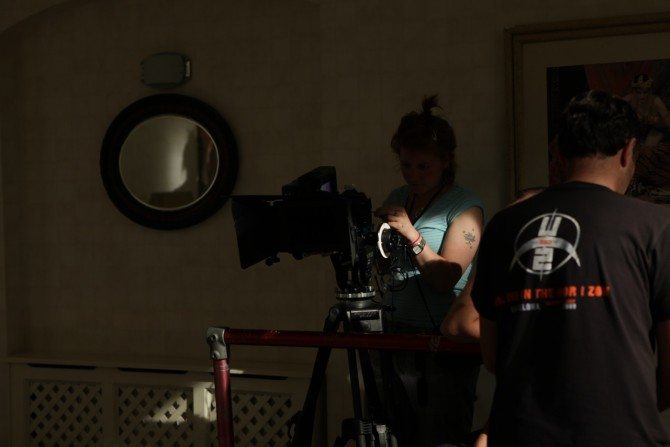
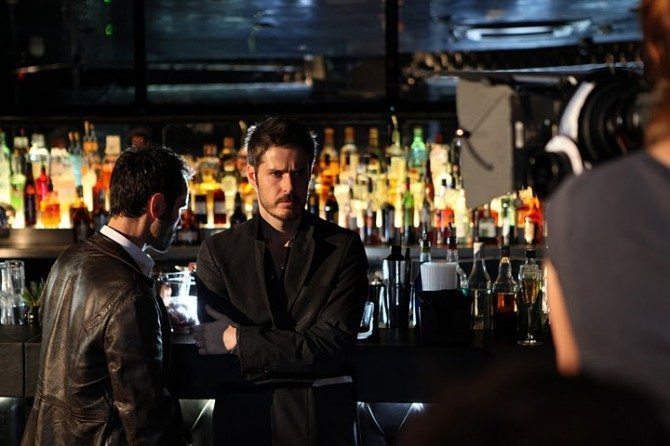
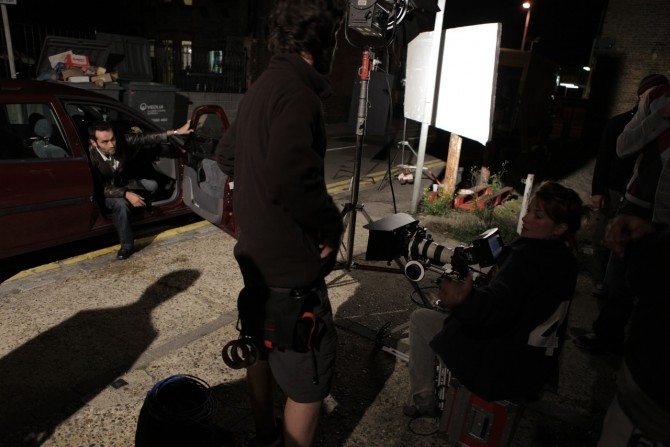
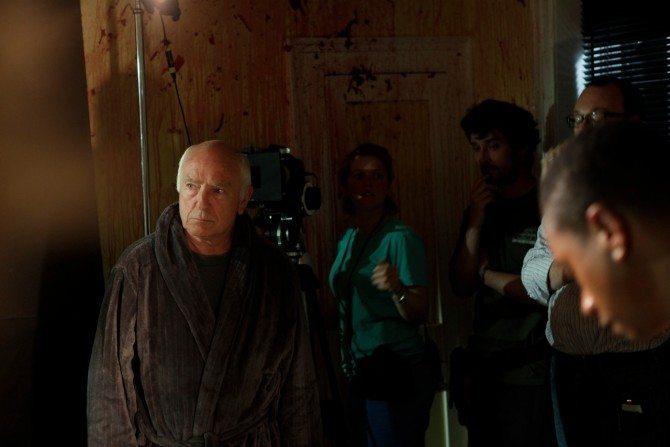
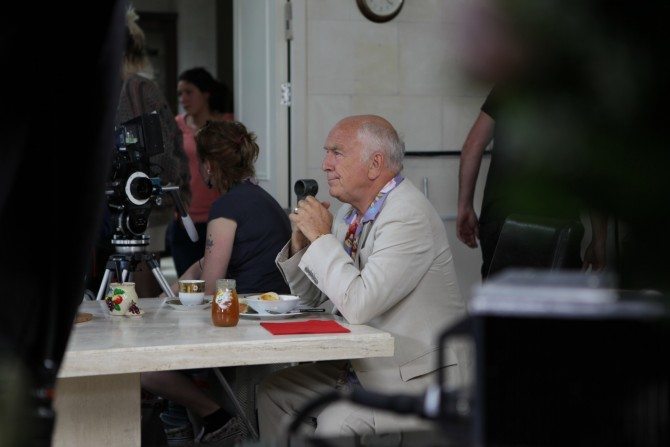
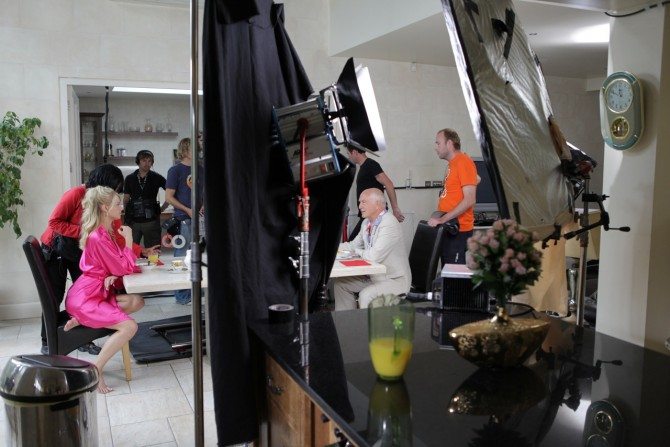
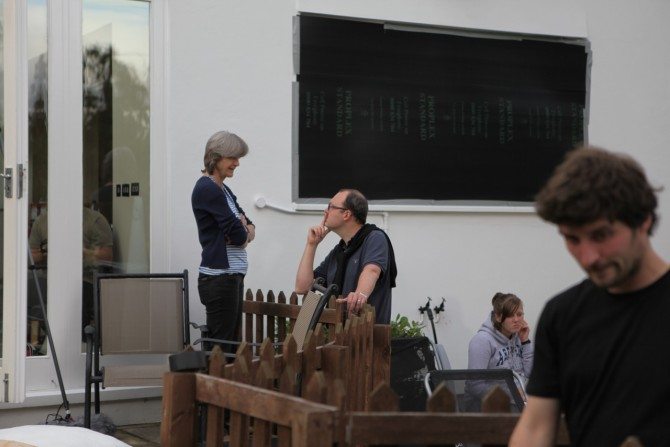
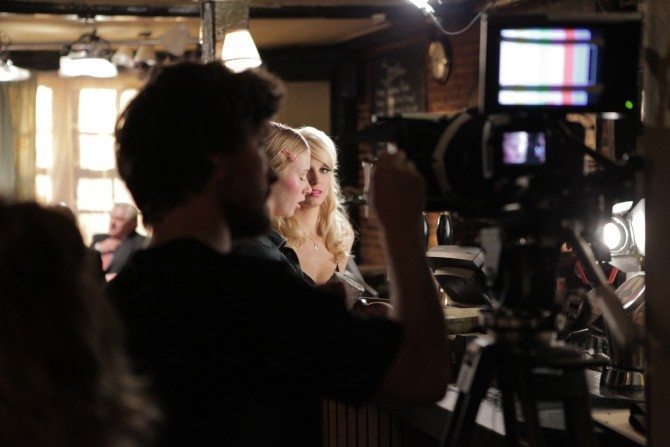
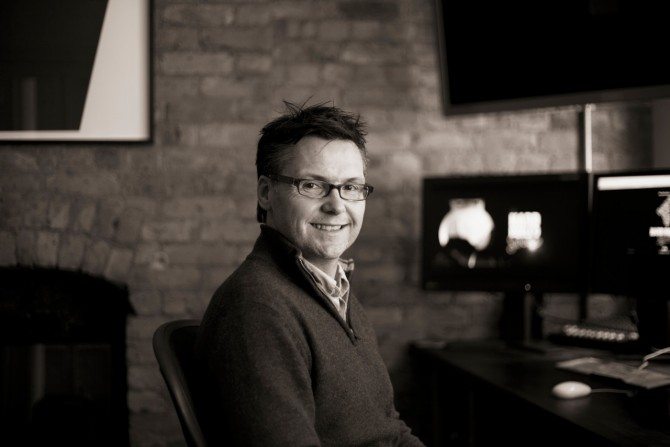
GB: Having had a long term working relationship with Dave Hughes going back to A GIRL AND A GUN, Dave kindly asked us if I would like to get involved in HARD BOILED SWEETS, which was a no brainer.
Dave and I spoke very early on in the process and having already edited and posted quite a few Canon 5D mkII productions from commercials, promos and channel idents we looked at how we could get the most out of the footage Dave was about to shoot.
We decided to look at a comparison between the H.264 and re encoding the material to pro res 4444. Now we know that this is a bit of a up conversion but after taking the footage into autodesk smoke and put on a bit of a grade and doing a comparison the difference was clear to see.
Dave then went to work re encoding the Canon files into pro rez 4444 files taking all the meta data across, so if we did miss something we could go back to the original H.264 footage if needed.
We then took the whole FCP project onto our mac/raid system. This gave us the benefit of having both the offline and online on the same fiber attached raid.
Having then exported an XML file from FCP we then transferred this to our Autodesk smoke system.
This then gave us a seamless work flow from offline to online keeping the meta data in tack, making our life very easy when any editor changes happened.
The footage was hard ingested onto the raid using Autodesk internal DPX file formate which would give us total flexibility, as we used a couple of Autodesk Flare seats to help with VFX’s and matting work.
Dave and I had at this point already chatted at great length as to the look he would like.
Feature film and still ref were invaluable in this process as they gave me a real understanding to the kind of look and feel Dave wanted.
Dave continued to edit away as we started to break down each scene and start to decide what was needed.
We chose the option of Autodesk smoke because we found it to be the best option for our workflow. Unfortunately we never had the option of Autodesk Lustre at that time, but this will be added to the pipeline on Dave’s next film.
I knew we would like to separate and isolate as much as possible on each shot, so having some great vfx and roto artist on board enabled us to have total control over the grade.
Using the Canon 5D mkII, we found that once looking at the footage on our in house ezio cg232W in depth we found quite a bit of digital noise. This is where having Andy Howard on hand for our colour management came invaluable
We took the decision to set up a flame batch pipeline in Smoke on mac even though this not installed on the smoke mac version.
Instead we used the modular keyer as batch. This gave us the flexibility to introduce de noise at the very beginning of each shot then grade on top of this using our imported roto work to isolate.
We also introduced some grading techniques on top of this using logic ops, this gave us the use of various blending functions to create a look Dave was after whether this was in the the shadows or the mid range or in the high lights.
Along with this in this same batch we took the decision to re-introduce some film noise at the back end which we sampled from one of David’s favourite movies.
Using this batch style pipeline also gave us the flexibility to stabilize , replace vfx’s and re edit whenever needed.
Using the 5D mkII footage had it’s problems, which as long as everyone is aware of in the beginning isn’t a problem because everyone know what they are working with.
After spending several months grading ( longer then usual for a feature, but with no studio breathing down our necks) we got what we needed.
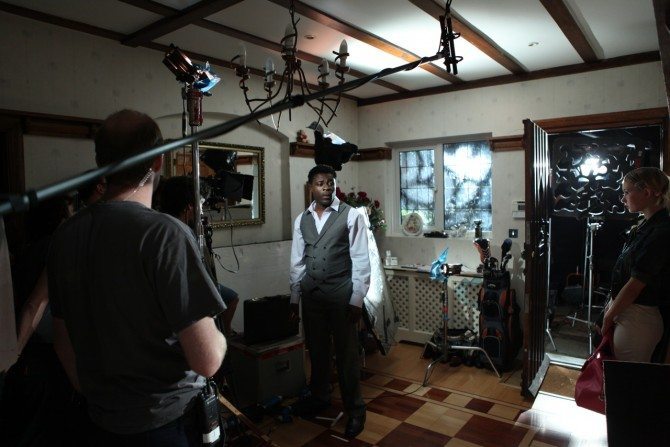
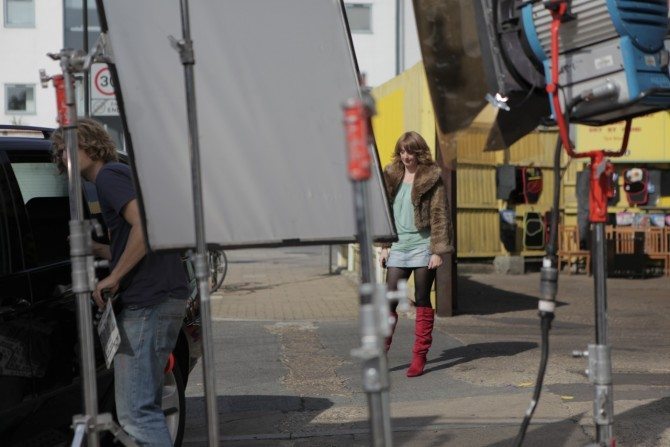
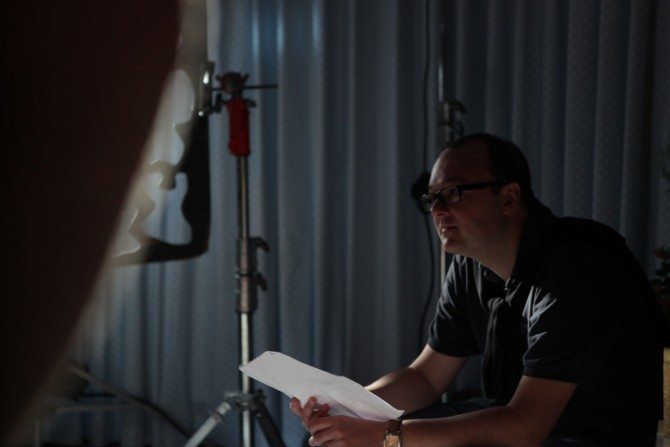
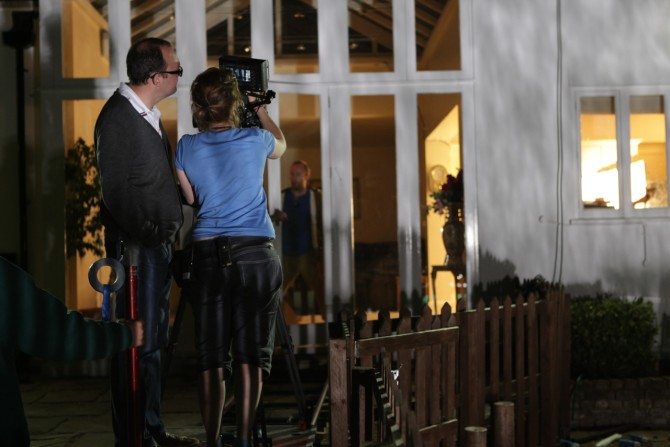
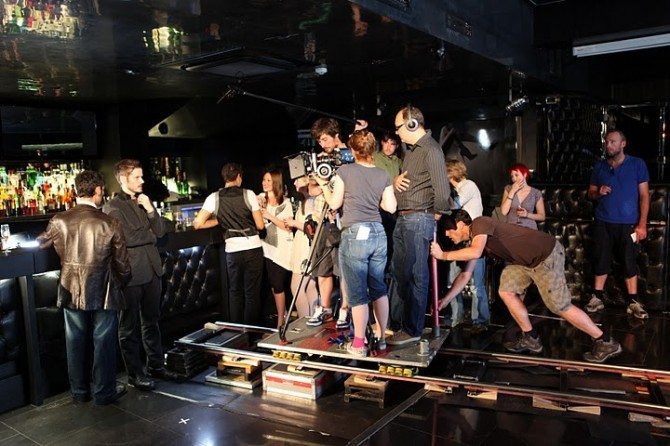
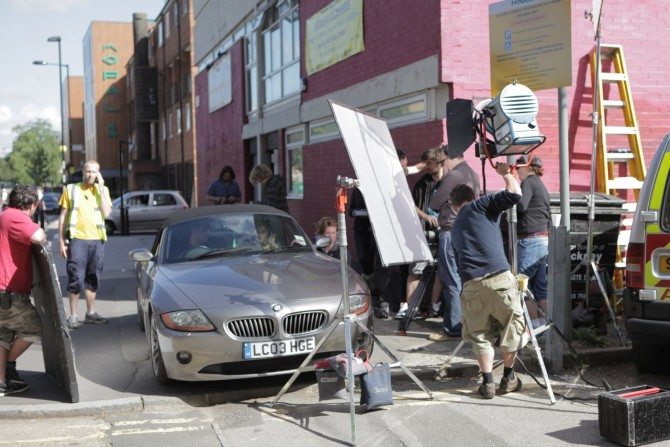
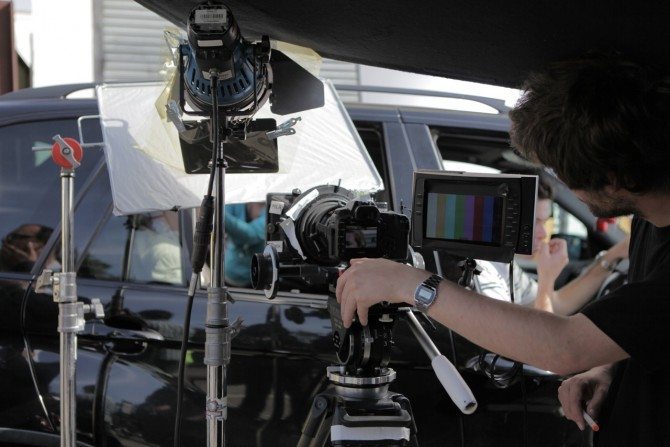
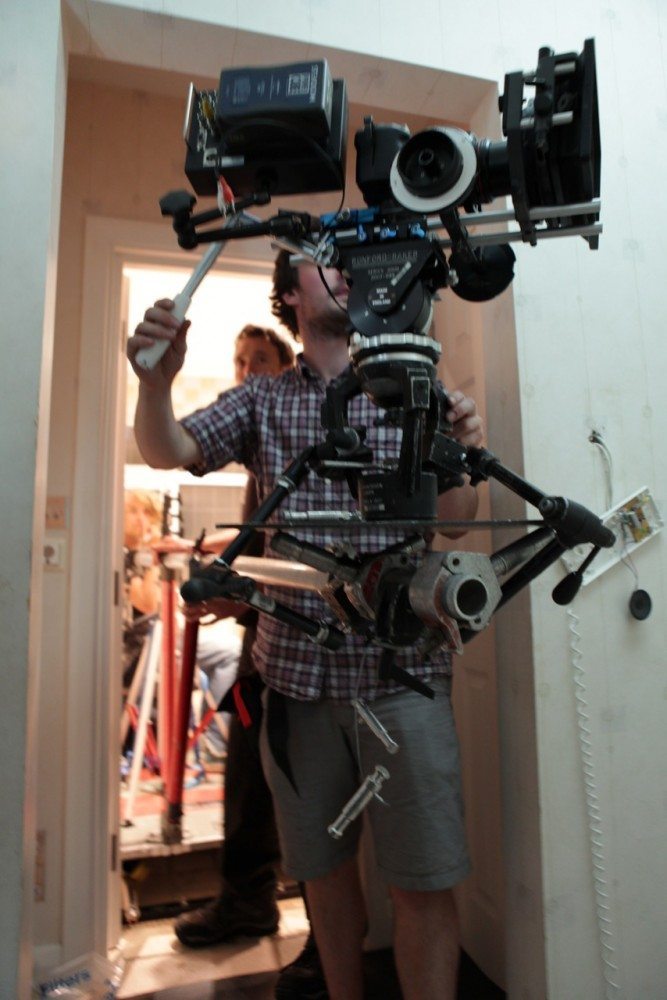
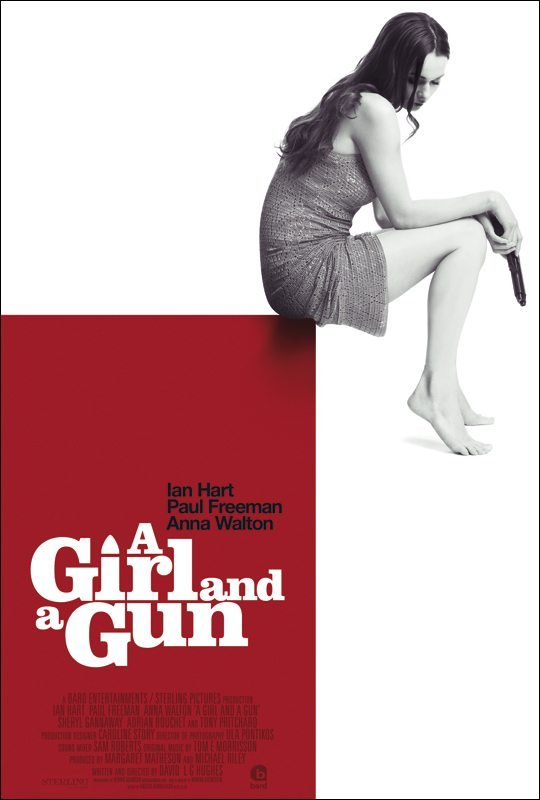
DLGH: I think this is a great time to add one of the best compliments the film has been given. When you deliver a film to a studio – as you’ll know, Philip – the movie has to go though QCing (Quality Control check). Basically some techno-whizz watches and studies every frame to check that everything is perfect. That everything that should be in focus is, that all the colours are legal, etc. etc. Well, the QCer for HARD BOILED SWEETS actually asked Gavin what film stock the movie had been shot on!
PB: Have you done a 35mm print? If so how does it look?
DLGH: No, but we’ve seen it projected from HDCam on to a cinema screen, and it looked amazing. Universal are having DCP’s made for the theatrical release – that’s what will be projected on to a cinema screen. And we’ll see that for the first time on March 9th at Leicester Square with everyone else when the film opens. Sara, Gavin and I (and a load of the cast and crew) are going to the evening screening at the Empire to watch the film with a paying audience for the first time. We can’t wait.
PB: Looking at the finished movie how happy are you and would you use the 5dMkII again?
Yes, absolutely. But it would depend on the project. I want to do an action movie next, and the rolling shutter doesn’t lend itself to that. But I think it’s a brilliant tool, when you embrace it fully.
Technically I’m thrilled and creatively I had final cut, so take full responsibility!
OFFICIAL FACEBOOK PAGE CLICK HERE

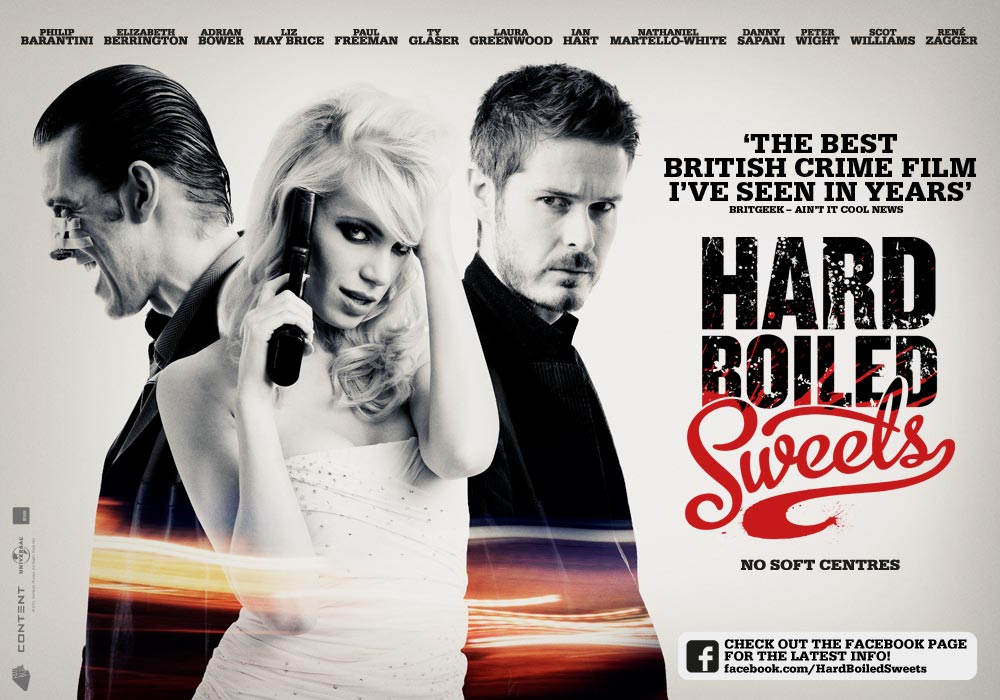



23 comments
Excellent article. Many thanks Philip. All the best with this project, guys.
thanks! I hope you’ll have the chance to see it 🙂
What ISO ranges were they using?
Hi Stuart, I was the focus puller on this film and can tell you that Sara Deane shot day exteriors at 100ASA, interiors at either 160ASA or 320ASA and night exteriors at 500ASA. We never shot anything above 500ASA. Shooting stop was almost always 2.8, never above 4.
Hope this helps,
Adam
yes, pretty much any iso’s between 100 and 500
Thank you very much for the report. I’m looking forward to the dvd/blueray release.
I’m sure the image will be very nice, but I’m astonished at the very bold move of choosing the 5D2 to shoot it. As everybody who has worked professionally knows, digital camera costs are pretty much irrelevant compared to the overall cost within any production. Choosing a DSLR rather than a proper camera not only is a very risky move, but it might end up being more expensive in the end, for all the additional post treatment 5D2’s files require. Pro grading suites are very very costly.
With Alexas going at €800/day and F3s at a much smaller fraction than that, I don’t think we’ll see many more DSLR-made movies, me thinks.
Hi Henry
Why astonished. Back when this was shot so many low budget films were being shot on the 5DmkII. There were no Alexas, F3s back then. It was this or a RED One back then to shoot it without shooting on film.
PB
This being a British movie was this filmed in 25p or 24p?
If there is a DVD or Blu-Ray release I can buy it from Amazon U.K, and use some software to make my drive region free.
Also there are Region free DVD and Blu-Ray players on Amazon most of the time you need to put a code in the player to unlock it.
Hi Mike, I was the focus puller on this film and can confirm that it was recorded at 24P, in case a film print was to be made. As far as I am aware, it is only being screened at the cinema digitally. I wouldn’t be able to tell you whether or not not it has been conformed to any other frame rate in post production, or what the DVD/Blu-Ray situation is.
Hope this helps,
Adam
Great news the Blu-Ray is region free.
Hard Boiled Sweets [Blu-ray][Region Free]
http://www.amazon.co.uk/Hard-Boiled-Sweets-Blu-ray-Region/dp/B005YXK89G/ref=sr_1_6?ie=UTF8&qid=1329873853&sr=8-6
Bad news the DVD is region 2
Hard Boiled Sweets [DVD]
http://www.amazon.co.uk/Hard-Boiled-Sweets-Paul-Freeman/dp/B005YWS7PE/ref=sr_1_1?ie=UTF8&qid=1329873853&sr=8-1
Hey Phil – any idea what the budget was for this?
Philip – the content on your site keeps getting better and better. Thanks for all the time and effort. It’s a wonderful resource.
Did you ever have to add extra light making it look rather bright on set, so that you could keep the ASA/ISO down to below 500? I find it hard to shoot anything indoors (at night or not near windows) and have my f stop anything higher than the about 1.8 to keep my ISO below even 800, which sometimes, I would like the deeper depth of field but I can’t have it for say a dolly shot or whatever, and end up underexposed or grainy. Thanks
yes we lit everything including day exteriors where we had power… 🙂
Great article, Philip – I saw this at the Empire on its opening Friday, purely to see what a DSLR feature would look like on the big screen. I’ll do a post on dvinfo.net soon with my thoughts … 🙂
Hi,
I am very interested in this “experiment”. My question is: did you printed to 35mm then? To you and to Philip, in general if not on this movie: how a 5D movie, treated so well like this one, with wonderful colors, contrast, details, would look like on a 35mm print? Does it gain too much grain and softness? does it loose too much detail? Would you ever do a print of you should only select DCP cinemas for a theatrical release?
thanks,
best regards and congrats for the excellent job.
it’s not an experiment…its a movie!
http://www.youtube.com/watch?v=Bnulqi3ZncU&feature=player_embedded
I’m sorry Philip, but a good, entertaining movie? This is a film that’s wallowing in cliche, and doesn’t mind that! In fact it’s positively pleased. It’s just a regurgitated slice of nothing. For me, that’s just not entertainment. Sorry for piling on the hate (I hate haters) but this doesn’t deserve to be called a good film. There’s just not enough thought in there.
If you didn’t like it that’s cool…what we like and don’t like is totally subjective in life.
Absolutely: not pushing my opinion onto anybody – just a statement of my personal views. Hope I didn’t
offend anyone at all? 🙁
Great info. Hope to see that feature.
Question: How does a focuspuller operate. I mean how can cameraman and focuspuller work on that same 5d?
The stage director peeking over the shoulder is something I can visualize.
Were any filters used while filming in front of the lens?
Thanks.
All the Best,
tronics
with an external monitor…